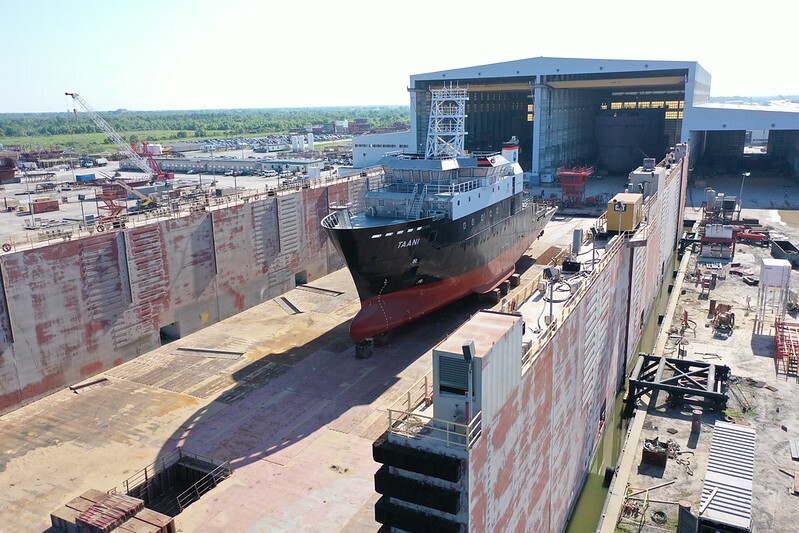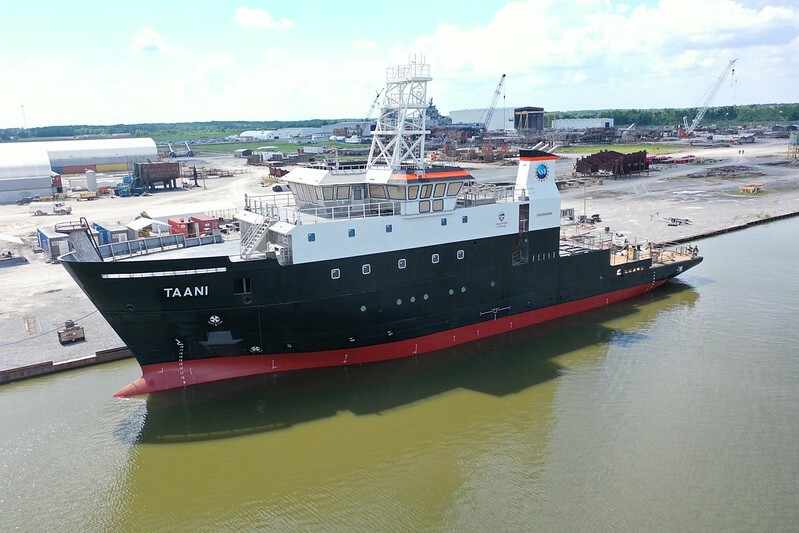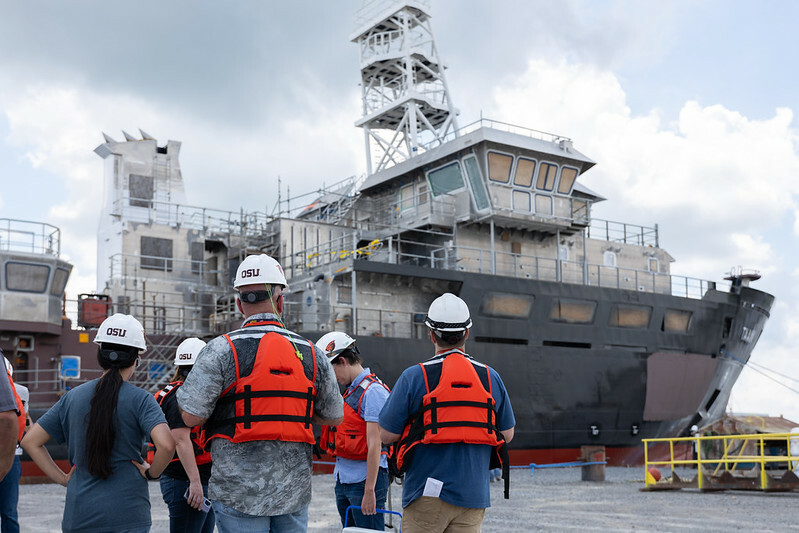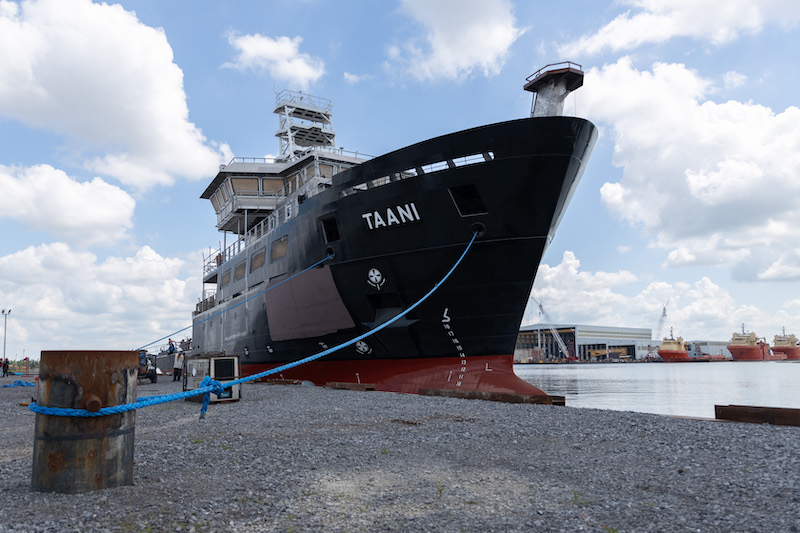The first of three new oceanographic research vessels dedicated to advancing marine science along U.S. coasts was launched Thursday.
The ships are being built at Bollinger Shipyards, Houma, La., with construction staggered about six months between each vessel.
The 199'6"x41'x19' Taani is being built as part of a project led by Oregon State University and funded by the U.S. National Science Foundation to provide scientists with valuable new tools to study critical issues such as rapidly changing ocean conditions and human impacts on the marine environment.
The vessel will feature a range of over 5,000 nautical miles, with berths for 16 scientists and 13 crew, a cruising speed of 11.5 knots, and a maximum speed of 13 knots. It will have a 12'6" draft.
The Regional-class research vessel (RCRV) project, supported by more than $390 million in grants, is charged with delivering three nearly identical ships to the U.S. Academic Research Fleet. Taani will be operated by Oregon State University and based in Newport on the Oregon coast.
“Seeing Taani in the water is a very special moment and signifies the promise of many scientific advances to come in the years ahead,” Tuba Özkan-Haller, dean of OSU’s College of Earth, Ocean, and Atmospheric Sciences, said in a statement.
OSU’s College of Earth, Ocean, and Atmospheric Sciences is overseeing the effort for the university.
The launch was led by Bollinger, which worked with LaShip, a subsidiary of Edison Chouest Offshore.
Once the ship’s hull was submerged 5’, teams of inspectors closely examined the interior for any leaks before completing the launch. The vessel, which is not yet under its own power, was then towed by a pair of tugboats back to where it was assembled at Bollinger Shipyards. It will remain docked there while construction and outfitting are completed.
The launch essentially concludes the major exterior construction on the vessel. The shipbuilders will now complete wiring and finish installing equipment and other construction tasks; carry out weeks of operational testing; and conduct sea trials to ensure the vessel is ready for its mission.

“It has taken tremendous dedication and an extraordinary team of designers, shipbuilders, scientists, inspectors, technicians and project and contract managers to bring Taani to life, but there is still much work to be done before the vessel is operational,” said professor Clare Reimers, Ocean Ecology and Biogeochemistry at OSU, and RCRV project scientist and co-principal investigator.
The second vessel, the Narragansett Dawn, will be operated by the East Coast Oceanographic Consortium led by the University of Rhode Island. The third vessel, the Gilbert R. Mason, will be based in the Gulf of Mexico. It will be managed by the Gulf-Caribbean Oceanographic Consortium, led by the Louisiana Universities Marine Consortium (LUMCON) and the University of Southern Mississippi.
The new research boats are equipped with new technologies and other features to enhance operational capabilities, improve safety, and expand ocean-based research. Each ship is designed to operate with 13 crew and up to 20 scientists for missions extending up to three weeks at sea.
“These are very technically advanced vessels, and getting the many systems that scientists use to all fit within the available internal space has been challenging,” said Demian Bailey, OSU’s principal investigator and project manager for the RCRV program. “Opportunities to build a ship like this don’t come along often, and we want to make sure the ocean science community is well-equipped for the next couple of decades.”

Construction of Taani is expected to be completed in 2024. After that, the ship and its new OSU-based crew will spend several months learning to operate the vessel, training on safety protocols, and conducting trials of the scientific tools, sensors, and equipment in the Gulf of Mexico before bringing the vessel through the Panama Canal and to its homeport in Newport. The first research expeditions aboard Taani are expected in 2025.
“The launch of the first RCRV, R/V Taani, is an exciting moment for the oceanographic research enterprise,” said Jim McManus, division director for the National Science Foundation’s Division of Ocean Sciences. “It is fantastic to see this elegant new ship in the water, and we are eager to see the ground-breaking science that will be forthcoming.”
Oregon State University was first awarded a cooperative agreement with the National Science Foundation to complete the RCRV design in 2013 and grants to build the three ships followed. The project was initially expected to take about 10 years but was delayed due to the Covid-19 pandemic; multiple Gulf Coast hurricanes, including Ida in 2021, that caused extensive damage at the shipyard and across Houma; and other challenges.
While the vessels are under construction in Louisiana, there is also a significant effort underway in Oregon to support the project. At an OSU warehouse in Corvallis, a “transition to operations” team is developing and testing scientific sensors and instrumentation; setting up the ships’ cyber infrastructure and ordering tools, equipment, and supplies that will be needed to operate the vessels — everything from spare propellers to galley equipment and more.
At Hatfield Marine Science Center in Newport, a $13 million project is in progress to renovate and upgrade the dock and improve the causeway to accommodate Taani. The original portion of the dock, constructed in the early 1960s, is being replaced with a wider trestle and the power system on the dock will be upgraded as well.
“With a new ship and a new pier, and the hiring of several new ocean-going scientists, we will be ready to get to work once Taani arrives in Newport,” Reimers said. “We have a lot of people who are excited to use this ship. Taani and her crews will shape the future of ocean science and education.”





